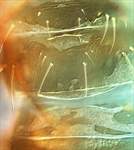Generic diagnosis
Medium sized, macropterous or apterous, Phlaeothripinae with median antennal segments bearing 5 or more sense cones. Head elongate, genae subparallel without strong setae; postocellar setae long and pointed; mouth-cone rounded; maxillary stylets retracted to postocular setae, close together medially; macroptera with compound eyes and ocelli well-developed; aptera without ocelli, compound eyes reduced or 2 or 3 facets. Antennae 8-segmented; segment II sensorium on basal half of segment; III–V each with at least 5–8 sense cones; VIII long and slender. Pronotum narrower than prothorax, anteroangular setae unusually close to anteromarginals, 2 pairs of epimeral setae; notopleural sutures complete. Prosternal basantra weak but with several pairs of setae; mesopresternum and mesoeusternum anterior margin weakly sclerotised; metathoracic sternopleural sutures broadly eroded. Metanotum weakly reticulate with pair of long median setae. Fore tarsal tooth long and stout; mid tibiae each with spur-like setae. Fore wings with duplicated cilia. Pelta broadly triangular but eroded in aptera; tergite II eroded laterally; median tergites without wing-retaining setae but with 3 pairs of long setae; tube short and stout, anal setae minute. Sternite VIII with a series of long posteromarginal setae. Male sternite VIII without pore plate.
Nomenclatural data
Streptothrips Priesner, 1932: 58. Type species Streptothrips mirabilis Priesner, 1932, by monotypy.\
There are 10 species described in this genus (ThripsWiki, 2022).
Australian species
Streptothrips tribulatius Mound & Minaei, 2006: 15
Relationship data
This is one of 10 Phlaeothripinae genera that are considered related to Plectrothrips and are placed in the Plectrothripini because of the basal position of the sensorium on the second antennal segment.
Distribution data
Various members of this genus have been described from the Caribbean, tropical Africa and Indonesia. One species is described from Cape Tribulation, Queensland, but very similar specimens have been studied from Yarraman, northwest of Brisbane, and also from Flinders Island, Tasmania.
Biological data
The members of this and related genera are all considered to be fungus-feeders on dead branches.
References
Mound LA & Minaei K (2006) New fungus-feeding thrips (Thysanoptera-Phlaeothripinae) from tropical Australia. Zootaxa 1150: 1–17.
Okajima S (1981) A revision of the tribe Plectrothripini of fungus-feeding Thysanoptera (Phlaeothripidae: Phlaeothripinae). Systematic Entomology 6: 291–336.
ThripsWiki (2022) ThripsWiki - providing information on the World's thrips. Available from: http://thrips.info/wiki/ (Accessed 15.iii.2022)



